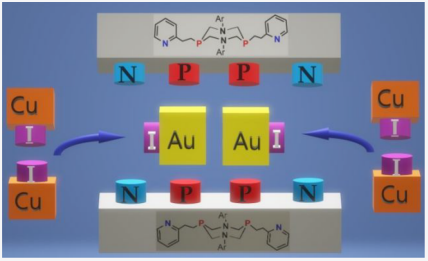by I. Dayanova, A. Shamsieva, I. Strelnik, T. Gerasimova, I. Kolesnikov, R. Fayzullin, D. Islamov, A. Saifina, E. Musina, E. Hey-Hawkins, A. Karasik
Inorg. Chem. 2021, 60, 7, 5402–5411
https://doi.org/10.1021/acs.inorgchem.1c00442

The row of metallocyclic dinuclear gold(I) complexes with cyclic diphosphines, namely, P-pyridylethyl-substituted 1,5-diaza-3,7-diphosphacyclooctanes, has been obtained. Further interaction of the dinuclear gold(I) complexes with copper(I) iodide gave the first examples of hexanuclear AuI/CuI complexes containing two unusual trinuclear AuICu2I2 fragments. The structures of di- and hexanuclear complexes were confirmed by NMR spectroscopy, ESI mass spectrometry, elemental analysis, and single-crystal X-ray diffraction. All of the obtained complexes are moderate emitters in the solid state. Dinuclear gold(I) complexes displayed a greenish emission with the maxima in the emission spectra at ca. 550 nm. The obtained hexanuclear heterobimetallic AuI/CuI complexes are triplet solid-state blue emitters with the maximum in the emission spectra at 463 and 484 nm. According to the TD-DFT calculations, the observed emission of all studied complexes had a triplet origin and was caused by the 3CC or 3(MLCT) T1 → S0 transitions for dinuclear and hexanuclear complexes, respectively.

 Русский (РФ)
Русский (РФ)  English (UK)
English (UK)